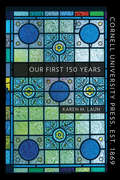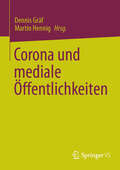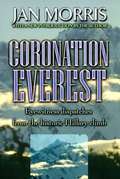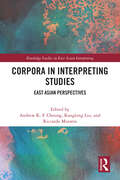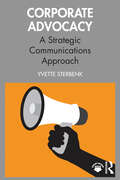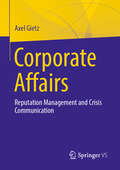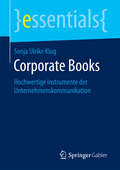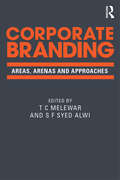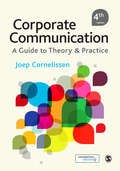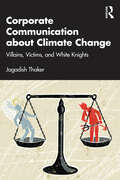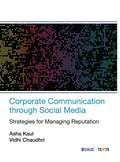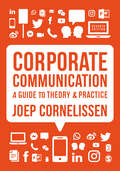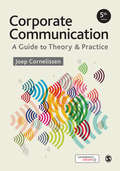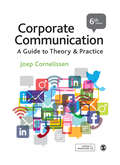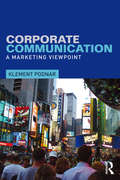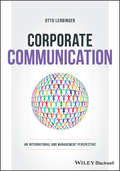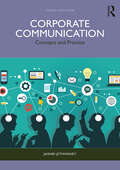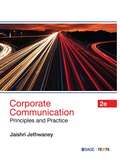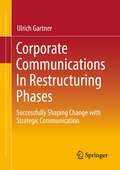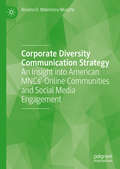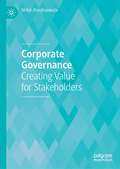- Table View
- List View
Cornell University Press, Est. 1869: Our First 150 Years
by Karen M. LaunA history of the first 150 years of Cornell University Press.
Corona und mediale Öffentlichkeiten
by Martin Hennig Dennis GräfDieses Buch bietet einen umfassenden, interdisziplinären Blick auf mediale Erscheinungsformen im Kontext der Corona-Krise und fokussiert in diesem Zusammenhang insbesondere medien- und kommunikationswissenschaftliche, linguistische und philosophische Perspektiven auf die öffentliche Kommunikation zum Themenfeld des Coronavirus. Gerade zu Beginn der Corona-Krise kam es aufgrund der aus der Neuartigkeit des Coronavirus resultierenden Ungewissheit zu signifikanten kommunikativen Störmomenten, deren Rekapitulation und Analyse für eine demokratische Gesellschaft unabdingbar sind. In diesem Sinne forscht dieses Buch nach den kommunikativen Mustern des öffentlichen Sprechens über das Coronavirus in fiktionalen sowie nicht-fiktionalen Formaten.Konkret werden im Rahmen der nicht-fiktionalen Formate TV-Nachrichtensendungen, TV-Talkshows und TV-Dokumentationen, Printnachrichten sowie Social Media-Posts analysiert. Im Rahmen der fiktionalen Formate stehen v.a. Online-Serien im Fokus des Interesses. Die unterschiedlichen, sich aus der Interdisziplinarität des Bandes ergebenden methodischen Zugänge ermöglichen einen breit gefächerten, polyperspektivischen Zugang zur Corona-Kommunikation und lassen gleichwohl (medien-)übergreifende diskursive Muster - als ein signifikantes Ergebnis des Sammelbandes - erkennen.
Coronation Everest
by Jan MorrisMay 29, 1953: Edward Hillary and Tenzing Norgay first reach the summit of Mount Everest, and nearly the Coronation Day for a new Queen, Elizabeth II. Breaking the story was James Morris, special correspondent for The Times, who met the victorious climbers at Camp IV at 20,000 feet. Morris known to millions of readers today as the travel essayist Jan Morris, wrote this account of the Hillary expedition with all the verve and sharp detail for which Jan Morris is famous.
Corpora in Interpreting Studies: East Asian Perspectives (Routledge Studies in East Asian Interpreting)
by Cheung, Edited by Andrew K. FCheung, Liu, Moratto, and their contributors examine how corpora can be effectively harnessed to benefit interpreting practice and research in East Asian settings. In comparison to the achievements made in the field of corpus- based translation studies, the use of corpora in interpreting is not comparable in terms of scope, methods, and agenda. One of the predicaments that hampers this line of inquiry is the lack of systematic corpora to document spoken language. This issue is even more pronounced when dealing with East Asian languages such as Chinese, Japanese, and Korean, which are typologically different from European languages. As language plays a pivotal role in interpreting research, the use of corpora in interpreting within East Asian contexts has its own distinct characteristics as well as methodological constraints and concerns. However, it also generates new insights and findings that can significantly advance this research field. A valuable resource for scholars of scholars focusing on corpus interpreting, particularly those dealing with East Asian languages.
Corporate Advocacy: A Strategic Communications Approach
by Yvette SterbenkProviding a foundational look at corporate advocacy from the perspective of strategic communications, this book develops strategies for authentic and meaningful ways companies can engage in advocating for social issues in order to have the strongest and most positive impact on society and their business.Customers, employees, investors, and other stakeholders increasingly expect companies to address complex, and sometimes divisive, sociopolitical issues. Communications professionals must determine how best to engage with those issues, both internally and externally, while considering a variety of operational and reputational factors. This text prepares readers to incorporate corporate advocacy into future communications roles in ethical, thoughtful, and strategic ways. It starts by providing a contextual and theoretical foundation for the topic, continues with an exploration of the perspectives of various stakeholder groups, and then focuses on the most ethical practices for communicating and acting on a company’s advocacy stance.Ideal as a primary text at the advanced undergraduate or master's level in a corporate advocacy course or a supplementary text in a corporate social responsibility (CSR) communication, public relations (PR), strategic communication, or marketing course, this text is also well suited to new professional communicators.An instructor’s manual with suggestions for in-class exercises and assignments and links to further resources is available at www.routledge.com/9781032595542.
Corporate Affairs: Reputation Management and Crisis Communication
by Axel GietzThis book offers a refreshing approach to the disciplines of Reputation Management and Crisis Communication – in short, to Corporate Affairs. Written by an outstanding practitioner of more than thirty years, the reader will find a unique blend of insights from rich professional experience, illustrated with real-life examples, and applicable academic theories. The content is sometimes surprising, but always germane to the subject matter, and comes from a consummate corporate storyteller who insists all effective communication must be interesting, relevant, and compelling. The origins of the text go back to a class taught at the University of Europe for Applied Sciences, Hamburg Campus. Target audiences are advanced undergraduates, specialists seeking guidance, and everyone following the news and at times asking themselves how businesses and their representatives can get it so wrong.
Corporate Books: Hochwertige Instrumente der Unternehmenskommunikation (essentials)
by Sonja Ulrike KlugDieser Leitfaden führt durch alle Entwicklungsstadien von Unternehmensbüchern und zeigt, worauf es ankommt. Die Autorin erläutert das spezielle Vorgehen bei der Planung, Realisierung und Vermarktung von Corporate Books als Premium-Instrumenten der Unternehmenskommunikation, damit ihre Vorteile ausgeschöpft werden können. Unternehmensbücher erhöhen den Bekanntheitsgrad, stärken die Markenidentität, dienen als Zugpferd für Kampagnen und unterstreichen den Expertenstatus für ein Thema. Sie können von Konzernen, Mittelständlern, Kleinunternehmern und Solopreneuren gleichermaßen eingesetzt werden. Corporate Books wirken langfristig und beeinflussen die Wahrnehmung eines Unternehmens durch die Öffentlichkeit positiv.
Corporate Books: Hochwertige Instrumente der Unternehmenskommunikation (essentials)
by Sonja Ulrike KlugDieser Leitfaden führt zuverlässig durch alle Entwicklungsstadien von Unternehmensbüchern. Kurz und komprimiert wird aufgezeigt, worauf es bei der Gestaltung und Vermarktung ankommt. Die Autorin erläutert das Vorgehen bei der Planung, Realisierung und Publikation von Corporate Books als Premium-Instrumenten der Unternehmenskommunikation.Unternehmensbücher haben viele Vorteile: Sie erhöhen den Bekanntheitsgrad, stärken die Markenidentität, dienen als Zugpferd für Kampagnen und unterstreichen den Expertenstatus für ein Thema. Sie können von Konzernen, Mittelständlern, Kleinunternehmern und Freiberuflern gleichermaßen eingesetzt werden. Gekonnt positioniert, entfalten Corporate Books ihre Wirkung langfristig und beeinflussen die Wahrnehmung in der Öffentlichkeit positiv.Die aktualisierte 2. Auflage wurde überarbeitet, verbessert und ergänzt.
Corporate Branding: Areas, arenas and approaches
by T C Melewar S F AlwiA strong corporate image has power in a competitive marketplace. Its influence on reputational value and customer decision-making is only now beginning to be understood. Interest in corporate branding is exploding as marketing academics and professionals begin to realize how it can boost business performance in measurable ways. For example, it promotes customer patronage without expensive advertising and raises profitability by enabling companies to leverage their brand image when buying from particular sources. Yet there are few empirical studies available to clarify its basic tenets and fewer still that help us understand corporate branding in different parts of the world. Existing books focus mainly on conceptual ideas and real-life examples. Corporate Branding: Areas, arenas and approaches is a unique take on corporate branding that provides a global overview through rigorous research of different geographical areas across industries. An international range of leading scholars contribute their coverage across three clear themes: Area: geographical areas across the globe including the UK, USA, Europe and Asia;Arena: a variety of commercial and not-for-profit sectors, both B2B and B2C;Approach: methodological approaches to brand research design, including qualitative, quantitative, case studies, interpretivistic and social narrative. These three themes enable the reader to consider corporate branding from more perspectives and in more ways than any other corporate branding book. The result is an understanding of this strategically important, growing subject that cannot be found anywhere else. This book is an essential read for any branding student or interested professional.
Corporate Communication
by Joep CornelissenWritten specifically for students interested in knowing more about the organizational and management context of communications, and to get more hands-on learning, practical experience and skills to help them get off to a flying start in their career, this book is a guide to corporate communication that will help students and practitioners navigate the area, understand the main theories and put these into practice through examples and case studies. Academically grounded, it covers the key concepts, principles and models within corporate communication by bringing together academic knowledge and insights from the subject areas of management and communication. At the same time, it combines this academic base with a clear practical outlook - practical cases illustrate the theory and each chapter also focuses on models and exercises that equip students with practical expertise and skills. The international scope of the book, featuring cases from around the globe has been instrumental in its success and has now been used by nearly 20,000 students across over 50 different countries from New York to Helsinki, Tokyo to Rio de Janeiro for students studying Corporate Communication, Organizational Communication, PR and Marketing Communications and as an invaluable source for reflective practitioners. The new fourth edition has been revised and updated with new cases and covers developments is areas such as reputation management, leadership communication and CSR communication. It features: A new chapter on social media and increased coverage of new media in existing chapters New up-to-date material on emerging CSR standards, transnational governance and corporate citizenship Extended focus on media relations, internal communications and leadership and change communication New full-length and shorter international case studies Enhanced companion website material including new case studies and video material available on publication at www.sagepub.co.uk/cornelissen4e
Corporate Communication about Climate Change: Villains, Victims, and White Knights
by Jagadish ThakerEmbedded in the emerging field of climate change communication, Thaker provides a comprehensive analysis of enablers and barriers to corporate action on climate change, business role and influence on media coverage of climate change, and its impact on public opinion and the policy-making process.Focusing on extensive academic research, business reports, case studies, and best practices from around the world, this book offers a practical guide to effective strategies in corporate climate change communication, including leadership communication, rebuilding public trust amidst greenwashing scandals, and engaging stakeholders with business action on climate change. The book provides new directions on the role of social media influencers, artificial intelligence, and big data in enhancing transparency in business actions and effective communication with key stakeholders.This book is an essential read for students, scholars, and professionals interested in the emerging fields of climate change communication, strategic communication, and related areas of sustainability and Environmental, Social, and Corporate Governance (ESG) communication.
Corporate Communication through Social Media: Strategies for Managing Reputation
by Asha Kaul Vidhi ChaudhriSocial media are rapidly and dramatically transforming the communication landscape. They are purported to provide reputational benefits by promoting transparency and enhancing possibilities for stakeholder engagement. However, they also present reputational risks by exposing organizations to new types of crises, stakeholder criticism, and digital activism. This textbook provides a comprehensive look at social-mediated developments in corporate and organizational communication and examines the consequent implications for reputation management. The book takes a grounded approach in bringing together perspectives from communication and management and from scholarship and practice. It helps the reader make sense of digitalization in corporate communication and its consequences for organization - stakeholder relationships, trust, engagement, leadership, and reputation. Covering a wide spectrum of topics such as branding, consumer engagement, employee relations, crisis communication, corporate responsibility and sustainability, and the return on investment (ROI), the book maps key changes in the evolving communication landscape, with an understanding of the strategic benefits and challenges for corporate reputation. Key Features • Blend of theory and practice of social-mediated communication and implications for reputation management • International focus with contemporary (and classic) examples and cases • Link with professional practice in "Voices from the Field" feature • Discussion questions and activities to encourage critical reflection and informed application
Corporate Communication: A Guide to Theory and Practice
by Joep P. CornelissenThis popular, market-leading textbook for corporate communication continues to be the authoritative and definitive textbook for students and educators. The text has been fully updated to include: • changes to the workplace in light of the Covid-19 pandemic and its impacts on employee communication via platforms such as Zoom and Microsoft Teams • the ongoing impacts of digital disruption and transformation on corporate communication at the advent of the ‘metaverse’ and alongside consideration of popular newer social media such as TikTok • the increasing focus on sustainability and the United Nations’ Sustainable Development Goals (SDGs); societal impact, purpose and corporate social responsibility; and the importance of social justice and inclusion within organizations and how these relate to organizational communication New case studies include Black Lives Matter (Starbucks); surveillance capitalism (Facebook); diversity and inclusion (Microsoft); and hybrid working (British Airways). This textbook is essential reading for communication courses including: corporate communication; organizational communication; management communication; strategic communication; and public relations. Joep Cornelissen is Professor of Corporate Communication and Management at Rotterdam School of Management, Erasmus University.
Corporate Communication: A Guide to Theory and Practice
by Joep P. CornelissenThis popular, market-leading textbook for corporate communication continues to be the authoritative and definitive textbook for students and educators. The text has been fully updated to include: • changes to the workplace in light of the Covid-19 pandemic and its impacts on employee communication via platforms such as Zoom and Microsoft Teams • the ongoing impacts of digital disruption and transformation on corporate communication at the advent of the ‘metaverse’ and alongside consideration of popular newer social media such as TikTok • the increasing focus on sustainability and the United Nations’ Sustainable Development Goals (SDGs); societal impact, purpose and corporate social responsibility; and the importance of social justice and inclusion within organizations and how these relate to organizational communication New case studies include Black Lives Matter (Starbucks); surveillance capitalism (Facebook); diversity and inclusion (Microsoft); and hybrid working (British Airways). This textbook is essential reading for communication courses including: corporate communication; organizational communication; management communication; strategic communication; and public relations. Joep Cornelissen is Professor of Corporate Communication and Management at Rotterdam School of Management, Erasmus University.
Corporate Communication: A Guide to Theory and Practice
by Professor Joep P. CornelissenUsed by nearly 25,000 students in over 50 countries, this book incorporates current thinking and developments on corporate communication from both the academic and practitioner worlds. Combining a comprehensive theoretical foundation with numerous practical guidelines, insights will assist managers (or soon to be managers) in their day-to-day work and in their strategic and tactical communication decisions. With cases and examples from across the globe including Apple, BMW, Uber, L’Oréal and Starbucks, the new edition is updated to include more material on social media, employee communication, leadership communication and anti-corporate activism. The Fifth Edition of Corporate Communication is supported by a Companion Website and includes Full text SAGE journal articles, glossary, web links for each chapter, author-selected videos relevant to the key themes and hot topics, an authors’ blog and author videos for students as well as case study notes, PowerPoint slides, and additional case studies for lecturers. Suitable for students at advanced undergraduate and postgraduate levels on business management, marketing, corporate communication, public relations or business communications programmes as well as practitioners in the field.
Corporate Communication: A Guide to Theory and Practice
by Professor Joep P. CornelissenUsed by nearly 25,000 students in over 50 countries, this book incorporates current thinking and developments on corporate communication from both the academic and practitioner worlds. Combining a comprehensive theoretical foundation with numerous practical guidelines, insights will assist managers (or soon to be managers) in their day-to-day work and in their strategic and tactical communication decisions. With cases and examples from across the globe including Apple, BMW, Uber, L’Oréal and Starbucks, the new edition is updated to include more material on social media, employee communication, leadership communication and anti-corporate activism. The Fifth Edition of Corporate Communication is supported by a Companion Website and includes Full text SAGE journal articles, glossary, web links for each chapter, author-selected videos relevant to the key themes and hot topics, an authors’ blog and author videos for students as well as case study notes, PowerPoint slides, and additional case studies for lecturers. Suitable for students at advanced undergraduate and postgraduate levels on business management, marketing, corporate communication, public relations or business communications programmes as well as practitioners in the field.
Corporate Communication: A Guide to Theory and Practice
by Professor Joep P. CornelissenThe Sixth Edition of Corporate Communication: A Guide to Theory and Practice? continues to be the market leading text in its field, having been fully revised by the author to reflect new trends and developments in social media and to capture emergent topics such as CEO activism and corporate character and purpose. New to This Edition: A revised chapter on comm's in the rapidly changing media landscape, incorporating new technologies and social media. Deeper coverage of key topics such as employee, crisis, and leadership communication alongside sustainability. New case studies with reflective questions to highlight the broad application of corporate communications. Corporations featured include: Apple, Facebook, Gilette, Lenovo and Nestlé. Corporate Communication is essential reading for students studying Corporate Communication, Organizational Communication, Strategic Communication, PR and Marketing Communications, as well as a valuable resource for reflective practitioners. It continues to be supported by comprehensive and fully updated online resources.
Corporate Communication: A Guide to Theory and Practice
by Professor Joep P. CornelissenThe Sixth Edition of Corporate Communication: A Guide to Theory and Practice? continues to be the market leading text in its field, having been fully revised by the author to reflect new trends and developments in social media and to capture emergent topics such as CEO activism and corporate character and purpose. New to This Edition: A revised chapter on comm's in the rapidly changing media landscape, incorporating new technologies and social media. Deeper coverage of key topics such as employee, crisis, and leadership communication alongside sustainability. New case studies with reflective questions to highlight the broad application of corporate communications. Corporations featured include: Apple, Facebook, Gilette, Lenovo and Nestlé. Corporate Communication is essential reading for students studying Corporate Communication, Organizational Communication, Strategic Communication, PR and Marketing Communications, as well as a valuable resource for reflective practitioners. It continues to be supported by comprehensive and fully updated online resources.
Corporate Communication: A Marketing Viewpoint
by Klement PodnarCorporate Communication: A Marketing Viewpoint offers an overview of the framework, key concepts, strategies and techniques from a unique marketing perspective. While other textbooks are limited to a managerial or PR perspective, this book provides a complete, holistic overview of the many ways communication can add value to an organization. Step by step, this text introduces the main concepts of the field, including discipline and function frameworks, corporate identity, corporate and employer branding, corporate social responsibility, stakeholder management, storytelling, corporate associations, identification, commitment and acceptability. In order to help reinforce key learning points, grasp the essential facts and digest and retain information, the text offers a comprehensive pedagogy, including: chapter summaries; a list of key words and concepts; case studies and questions at the end of each chapter. Principles are illustrated through a wealth of real life examples, drawn from a variety of big, small, global and local companies such as BMW Group, Hidria, Lego, Mercator, Krka, Barilla, Domino's Pizza, Gorenje, Si Mobil, BP, Harley-Davidson and Coca-Cola. This exciting new textbook is essential reading for all professional corporate marketing and communication executives, as well as undergraduate and postgraduate students of marketing and public relations, not to mention managers who need a complete and accurate view of this increasingly important subject.
Corporate Communication: An International and Management Perspective (Routledge Communication Ser.)
by Otto LerbingerProvides an international and management perspective on the field of corporate communication Corporate communication plays an important role in higher-level management to help build and preserve a company’s reputation. This intangible yet valuable asset determines the net worth of a company and affects the success of its operations. Corporate Communication: An International and Management Perspective introduces readers to the broad environment of the modern extended organization and provides an understanding of the globalization process. It describes how economic, political, and cultural features of a country affect company decisions and communication and discusses various communication disciplines and practices that are employed in programs and campaigns. This book addresses the key management issues of sustainability and technology and innovation. It also emphasizes the importance of why corporate communication must be seen as a management function and not restricted to a communication process. Presented in five parts, Corporate Communication offers comprehensive chapters covering: The Domain of Corporate Communication; Strategic Application of Communication Practices; International Perspective; Key Management Issues of Sustainability and Technology; and Corporate Communication Contribution to Management. The foundation of Corporate Communication is public relations but also included is the entire range of communication practices and the contribution to management decision making. Conceptualizes corporate communication as a strategic management function which helps management recognize, adjust to, and construct policy related to global issues Emphasizes the critical role that corporate communication plays in making corporate decisions and behaviors more socially responsible and sustainable Demonstrates how corporate communication draws on public affairs, marketing and social media in its strategic planning Emphasizes the critical importance of relationships to corporations and their effect on reputation Provides numerous examples of cases of global problems and how corporations have responded to them Corporate Communication is intended for upper-level undergraduate and graduate students in schools of communication and schools of business and management who want to extend their competence to the global arena and to combine the various communication practices to design strategic programs and campaigns. Course titles include corporate communication, international public relations, corporate public affairs, global marketing communication, global corporate communication, and social media.
Corporate Communication: Concepts and Practice
by Jaishri JethwaneyCorporate Communication: Concepts and Practice—a comprehensive and engaging textbook—helps in understanding the underlying concepts and real-life strategies of communication in modern-day corporate set-ups. One of the youngest management disciplines, corporate communication is used by companies to position themselves to the outside world in a highly competitive business environment and to build a “sense of being,” on the one hand, and creating a feeling of pride in being associated with the company for various stakeholders, especially the employees and investors. Some of the functions of corporate communication include identifying and segmenting stakeholders, articulating brand positioning, selecting appropriate channels of internal and external communication, and managing crises, conflicts, and reputations, among others. This revised edition offers a fresh perspective into all basic and critical aspects of corporate communication and incorporates the latest changes in governmental policies and industry trends to aid students adapt to the contemporary business environment and become industry-ready. This book will be of great interest to students and researchers working in the areas of corporate communication, organizational communication, journalism, mass communication, communication studies, public relations, and human resource management.
Corporate Communication: Principles and Practice
by Jaishri JethwaneyA comprehensive and engaging textbook that helps in understanding the underlying concepts and real-life strategies of communication in modern day corporate set-ups. A non-exhaustive list of the functions of corporate communication involves identifying and segmenting stakeholders, promoting brand positioning, selecting appropriate channels of internal and external communication, and managing crisis and reputation, among others. This second revised edition of Corporate Communications: Principles and Practice - a well-accepted textbook designed for the students of mass communication, public relations and journalism - offers a fresh perspective into all basic and critical aspects of corporate communication. It incorporates the latest changes in governmental policies and industry trends in the country to aid students relate to the contemporary environment and become industry-ready. Key Features: Incorporates the changes brought about by Companies Act 2013 (CSR practices), tax reforms by Government of India (GST in place of multiple indirect tax structure) and others Includes citations from Encyclopedia on Corporate Reputation for global perspectives on issues. New global and Indian case studies with points for discussion and analytical inputs
Corporate Communications In Restructuring Phases: Successfully shaping change with strategic communication
by Ulrich GartnerThis book provides those responsible in communication, management and human resources with a practical guide for professional internal and external communication of restructuring programs in companies. From cost-cutting measures to downsizing to the closure of entire locations: changing economic framework conditions and the associated changes are not only an operational challenge, they also require intelligent communication. If this fails, long-term costs through collateral damage such as declining employee motivation or loss of reputation can wipe out the short-term savings.This book shows in a compact way how you can identify key stakeholders, define communicative goals and develop the infrastructure, content and instruments with which you can strategically achieve these goals.The author gives concrete tips, describes concrete procedures and asks targeted questions for success in difficult times.
Corporate Diversity Communication Strategy: An Insight into American MNCs’ Online Communities and Social Media Engagement
by Roxana D. Maiorescu-MurphyThis book analyzes the brand communities of major American multinationals across three industries: finance, tech, and consumer goods. It assesses how companies communicate their diversity approaches on social media (Twitter) and studies the ensuing perceptions of online users. By comparing more innovative sectors (tech and consumer goods) with a less innovative industry (finance), the author examines differences in the way brands approach and communicate about diversity in online settings. The results of the study lead to the development of a theoretical framework with practical applications for business communication academics and professionals alike.
Corporate Governance: Creating Value for Stakeholders
by Shital JhunjhunwalaThe book covers the broad area of Corporate Governance (CG) and its constituents. It includes new and contemporary topics such as CG in family-controlled businesses, governance of multinational corporations, related party transactions and impact investing. It is a blend of theory and practice, and presents cases old and new, from Maxwell to Tata Sons, from both the western and eastern hemisphere to facilitate the understanding of CG issues. The book brings together governance frameworks of different countries in one place. For instance, when ‘appointment of auditors’ is discussed the UK code, US laws, EU Audit legislation 2016 and Indian rules are covered. It includes latest and novel regulations such as CSR in India.
